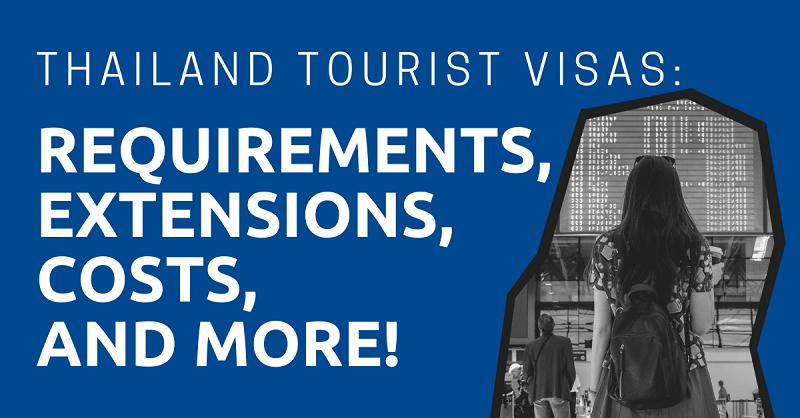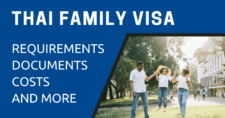
If you’re planning your trip to Thailand and trying to figure out which Thailand tourist visa you’ll need, then you’ve landed on the right page.
In this guide you’ll find out which tourist visa is right for you, the requirements for getting a tourist visa, how to apply for and extend your tourist visa, and lots of other useful tidbits.
"*" indicates required fields
Disclaimer: This article may include links to products or services offered by ExpatDen's partners, which give us commissions when you click on them. Although this may influence how they appear in the text, we only recommend solutions that we would use in your situation. Read more in our Advertising Disclosure.
Contents
(And How It’s Costing Them)
Most expats throw money away, get lost in red tape, and miss the local hacks that make life easier and cheaper. ExpatDen Premium gives you the secrets seasoned expats use to save, earn, and thrive beyond the basics, saving you thousands and opening doors you didn’t even know existed.
Here’s what’s inside:
- Housing Hacks: Slash your rent by 40% or more - because the locals are laughing at what you’re paying.
- Banking Mastery: Stop wasting on fees and get top exchange rates. Why give your money away?
- Healthcare for Local Prices: Quality treatment without the expat price tag.
- Visa and Legal Shortcuts: No more bureaucratic nightmares. Get the visa and residency secrets that others pay their lawyer dearly for.
- Deep Discounts: Find the savings locals rely on for groceries, dining, and more.
If you’re serious about making Thailand work for you, join ExpatDen Premium and make Thailand work for you.
What is it?
A Thailand tourist visa lets non-Thais come to Thailand for the purpose of traveling, visiting friends and family, getting medical treatment, or attending meetings, conferences, seminars, and similar events.
The amount of time you can stay in Thailand on a tourist visa depends on which type of visa you have, by typically you’ll get either 30, 60, or 90 days before extensions.
How Many Types are There?
In general, you have four different options with Thailand tourist visas: visa-exempt stamp, visa on arrival, single-entry tourist visa, and multiple-entry tourist visa. Visa-exempt stamps and visas on arrival are only available for residents of certain countries.
Visa-exempt Stamp
A visa-exempt stamp, or tourist visa waiver, allows eligible foreigners to stay in Thailand for 14 to 90 days without a visa.
The duration of stay depends on your nationality.
- If you are from Myanmar, you can stay in Thailand for 14 days with a visa-exempt stamp.
- If you are from the USA, Europe, Australia, Canada, and other countries, you can stay in Thailand for 60 days with a visa-exempt stamp. Note that this is a special extension for 2025, as the usual stay is 30 days for citizens of these countries.
- If you are from Brazil, Chile, South Korea, and other nations, you can stay in Thailand for 90 days with a visa-exempt stamp.
- Check Wikipedia for a full list of countries that can enter Thailand without having to make a visa.
While you don’t need to apply for a visa in advance with this scheme, there are a few things you should have in hand, including:
- a passport that’s valid for more than 6 months
- a proof of onward travel such as a return flight ticket
- proof of funds, which is THB20,000 cash per person or THB40,000 for a family
Please note that in many cases, an immigration officer won’t ask for it unless they see some suspicious activities in your passport. If you don’t these proofs, you might get a denied entry.
Visa on Arrival
If you’re from one of the countries on the left in the this chart then you’re eligible for a 15-day visa on arrival when you travel to Thailand by air. To qualify for a visa on arrival, you must show proof of onward travel dated no later than 15 days from the date you enter Thailand.
Bus, train, or van tickets with no fixed return date are not considered proof of onward travel.
Single-entry Tourist Visa
If you want to stay in Thailand for up to 90 days, you can get a single-entry tourist visa (SETV). With this visa, you’ll be given an initial 60 days in the kingdom, starting on the day you enter Thailand. After which you can extend for another 30 days.
Normally, a tourist visa will be available for 90 days after your visa is approved. You must enter Thailand before the ENTER BEFORE DATE on your visa.
If you don’t, your visa will expire. If you leave Thailand while on a single-entry tourist visa, it will also expire–unless you get a re-entry permit.
Multiple-entry Tourist Visa
If you want to stay in Thailand for more than 90 days, getting a multiple-entry tourist visa (METV) is the way to go.
With this visa, you can exit and enter Thailand as many times as you’d like during the visa’s six-month validity. Since you’re allowed to come and go as many times as you’d like, you can get a total of 270 days on the visa.
Unlike with single-entry tourist visas, you don’t have to get a re-entry permit when leaving Thailand on your multiple-entry tourist visa. But you have to apply for the multiple-entry tourist visa at a Thai embassy in your country.
The Royal Thai Consulate General in Melbourne is an exception. They let non-Australians apply for multiple-entry tourist visas.
Thailand Privilege Visa
The Thailand Privilege Visa is a privilege visa in Thailand. Although it is for those who want to stay in Thailand long-term, it’s considered a tourist visa.
It lets you stay in Thailand from five to 20 years as if you can pay the application fee and don’t have a criminal background.
What are the Requirements?
Different rules apply to different nationalities, but one requirement governs everyone who’s applying for a Thailand tourist visa: a passport with at least six months validity. This is a simple requirement, but you shouldn’t overlook it.
If you have had to re-enter the country several times, you may be asked for proof of funds and proof of onward travel as well.
Passport
You need to have a passport with at least six-month validity.
Although many people won’t have any trouble getting into Thailand of they don’t have at least six months validity on their passport, one person’s experience will be different from another person’s.
This means you can have a passport that’s only valid for three months and have no trouble with Thai Immigration, or you can have a passport that’s still valid for six months and be denied entry.
When it comes to foreign immigration laws, the cardinal rule is: you’re better off being safe than sorry.
Proof of Funds
You need to show proof of funds, 20,000 baht per person and 40,000 per family, when applying for a tourist visa and a visa on arrival.
Even if you come to Thailand on a visa exemption scheme, you may still need to show it.
Immigration officers might ask for proof of financial means based on one of the Immigration Act of Thailand’s rules regarding “Having no appropriate means of living following entry into the Kingdom.” However, this rarely happens.
Having proof of adequate funds as a means to re-enter the country has been a subject of inquiry for many.
Proof of Onward Travel
Aside from proof of funds, you’ll have to show proof of onward travel; for example, a plane ticket dated no later than 30 days from your date of entry into Thailand. Overland travel tickets by bus, train, or van, and tickets with no fixed return date don’t count.
Again, with the exception of nationalities under the visa on arrival rule, you’ll rarely be asked to show a return ticket when traveling in and out of the country. However, if you’ve made several entries–regardless of the number of days in between each entry–there’s a good chance you’ll be asked to show proof.
What are Some Restrictions?
Despite popular belief, you can’t do anything and everything with a Thailand tourist visa. Here are a few important restrictions.

Abusing Visa-exempt Stamp
Because border-bouncing foreigners have been taking advantage of the visa-exempt stamp, Thai Immigration officers have become privy to their abuse.
Thai Immigration counts the number of entries on a passport under a visa-exempt stamp. While they don’t count back-to-back entries, they do count the total number of visa-exempt stamps you’ve had.
For example, if you’re from Singapore and come to Thailand once a month over the course of a year, your coming and going will raise a red-flag with Thai Immigration, even if you stay in Thailand for only a day.
This doesn’t mean, however, that you will be banned from entering Thailand, it just means Thai Immigration is likely to question your motives for wanting to enter Thailand.
If this happens, you can show proof of onward travel or proof of financial support. This might help. But ultimately, whether or not you’re allowed in Thailand will lie in the hands of the immigration officer, who will asses your entry based on your passport’s history, and decide from there.
But if you travel to Thailand on a visa-exempt stamp frequently and leave when you’re supposed to, you shouldn’t run into any problems with Thai Immigration. They may question you, but if you’re following the rules, you’ll be okay.
If you come to Thailand by flights, you may come in and out of Thailand as many times as you want, as long as you have good reasons that you are not abusing it.
While you’re not exactly violating any immigration laws, abusing this privilege will eventually raise a red flag. You’re not going to find an official list of rules that says the number of times you can get away with constantly getting a visa-exempt stamp.
But suspicious travel patterns will have immigration officials taking a closer look at your visas.
Single-entry and Multiple-entry Tourist Visa
If you apply for back-to-back single-entry tourist visas you will raise red flags with Thai Immigration officers.
You shouldn’t have more than three to five tourist visas in your passport at any given time.
But even if you get a new passport, immigration officers can verify the number of times you’ve applied for a tourist visa. And if you try to beat the system by extending your tourist visa for 30 days by doing a border run, and then repeat the process, expect immigration officers to question you.
Again, you may not be violating any immigration laws, but by not getting the right visa for your long-term stay in Thailand could make immigration officers wonder whether you’re in Thailand for tourism, or work.
Which leads to my next point. If you’re looking for a job in Thailand while on a tourist visa, and you get a job, you’ll have to leave Thailand and return with the right visa.
Where Can You Apply?
The application process for a Thailand tourist visa depends on the country you’re in.
In most cases, you can apply online through the E-Visa system by creating an account, uploading all required documents, and paying the visa fee online. You should expect to receive an electronic visa within a few days. After that, print it out and bring it with you to Thailand.
If the E-Visa system isn’t available in your country, you will need to contact the nearest Thai Embassy or Consulate.
How Much Does It Cost?
The cost of your Thailand tourist visa will depend on which country you’re from.
On average, though, you’ll usually pay THB1,900 for a single-entry tourist visa and THB5,600 for a multiple-entry tourist visa, depending on your currency and exchange rates.
How Do You Get an Extension?
You can extend your tourist visa or visa-exempt stamp once, which gives you an additional 30 days in Thailand at any Thai immigration office. If you’re from India, keep in mind you’ll get a 7-day extension.
Here’s what you need to do:
- Go to the nearest immigration office. Here’s a list of most of them.
- Prepare the following documents:
- A passport valid for at least six more months
- A 4cm x 6cm photo, taken in the last six months
- A copy of your passport and entry stamp
- An application form, which you can pick up at the immigration office
- Your contact details: address and cell phone number
- THB1,900 for a visa extension fee
- Go to the information counter and inform them that you are there for a visa exemption.
- You will receive a queue number.
- Wait for your turn and submit all the documents to an immigration officer.
- You will receive a new visa stamp granting you 30 more days in Thailand.
The whole process normally takes around 3 hours. If there’s no queue, it can take less than 15 minutes.
Most immigration offices in Thailand open from 8:30am to 4:30pm. And most offices stop handing out queue numbers after 3:00pm. Get there before 2:00pm if you want to handle you visa extension in one day.
If you have a visa on arrival, you can’t get an extension unless you’ve fallen ill in Thailand. In this case, you can apply for a 7-day extension at an immigration office in Thailand for 1,900 baht, or a 15-day extension for 1,000 baht.
If you’re denied a 15-day extension, immigration officials will give you an “Extension Denied Stamp,” which will usually give you 7 extra days anyway.
What Happens if You Overstay?
If you overstay your tourist visa in Thailand, you’ll have to pay THB500 per day you stay in the kingdom past your visa’s expiration date. Usually, the fine won’t be more than THB20,000 if you overstay for 40 or more days.
If you slip up and forget to extend your visa or apply for a new one, and you overstayed your visa’s expiration date, head to one of the immigration offices in Thailand to sort things out immediately.
If they come looking for you, or find that you’ve overstayed your visa during a random check, it could lead to you being detained or blacklisted from Thailand.
Now, on to You
Thailand tourist visas are one of the easiest visas to apply for in Thailand. And if you’re looking to stay in Thailand for under a year, they’re also your best choice. But depending on which country you come from, your application process and requirements may or may not be similar to other applicants. So be sure to go back and read through this guide thoroughly.
And don’t forget to get travel insurance in case you get sick or injured in Thailand.








